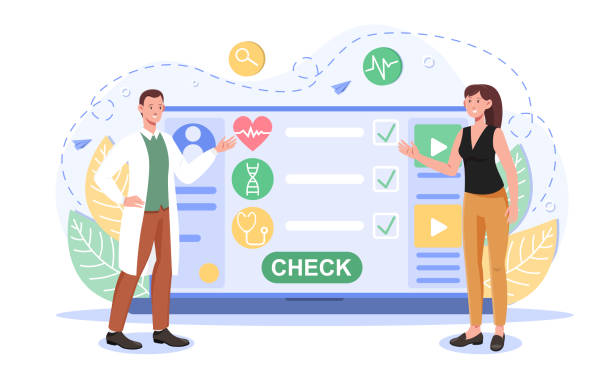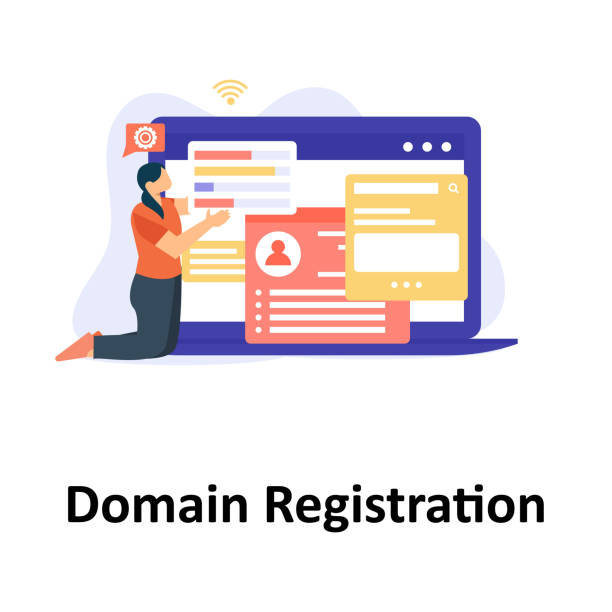An Introduction to Responsive Website Design and Its Importance

In today’s world, where users access the internet from various devices, the importance of #responsive_website_design has become more evident than ever.
This approach ensures that your website is displayed correctly on any screen size, from small smartphones to wide monitors, providing a consistent user experience.
Responsive design means a website’s adaptability to the visitor’s environment, which includes screen size, orientation (horizontal or vertical), and platform.
This concept helps developers reach all users with a single codebase, eliminating the need to design separate versions for mobile, tablet, and desktop.
Recent advancements in web technologies have made mobile usage an inseparable part of daily life, so responsive website design is no longer a luxury option, but a necessity for every business and website.
Without this approach, businesses may lose a large segment of their audience who use mobile devices and fall behind in competition.
This issue is not limited to user experience; it also has a direct impact on website SEO.
Search engines prioritize responsive websites, which means higher rankings in search results and greater visibility.
This chapter, in an explanatory and educational manner, discusses the fundamentals and reasons for the importance of designing a website compatible with various devices.
In fact, the main goal of responsive website design is to provide a unified and optimized user experience, regardless of the type of device the user employs to browse the website.
This greatly helps maintain user engagement with your content and increases conversion rates.
Ignoring this issue can lead to high bounce rates and a decrease in online credibility.
Does your current website convert visitors into customers or drive them away? Solve this problem forever with professional corporate website design by Rasawweb!
✅ Build strong credibility and branding
✅ Attract target customers and increase sales
⚡ Get a free consultation now!
Key Principles and Main Components of Responsive Design

To effectively implement #responsive_website_design, there are three key principles that every developer should pay attention to: Fluid Grids, Flexible Images, and Media Queries.
#Fluid_Grids means that instead of using fixed pixel units, relative units like percentages are used for element widths.
This ensures that the website layout automatically adapts to the screen width.
For example, if a column occupies 20% of the page width, it will always remain 20%, regardless of the screen size.
Flexible_Images follow the same logic; instead of defining fixed dimensions for images, their maximum width should be set to 100% so that images automatically adjust to the available space, preventing them from overflowing or appearing too large.
This approach not only helps improve the user experience but also optimizes page loading.
Media Queries or Media Queries are the most powerful tool in responsive website design.
They allow you to apply different CSS styles based on device characteristics such as screen width, height, orientation, and resolution.
For example, you can define that on screens with a width less than 768 pixels, the navigation menu is displayed as a hamburger icon, and on larger widths, it is displayed horizontally.
This specialized and educational approach provides precise control over the appearance and functionality of the website on different devices.
Simultaneous and optimal use of these three components forms the basis of a successful adaptive design and greatly contributes to the stability and flexibility of your website in the future.
A deep understanding of these principles is essential for any developer seeking to create innovative web experiences.
Benefits of Responsive Design for Users and Businesses

Implementing #responsive_website_design has significant benefits not only for users but also for businesses.
From a user’s perspective, the most important advantage is a #integrated_and_optimized_user_experience.
Users no longer need to switch between different versions or struggle with zooming and horizontal scrolling to view the website on various devices.
A positive user experience leads to increased satisfaction, reduced bounce rate, and increased user time on the site.
These factors directly impact conversion rates and sales.
From a business perspective, one of the biggest advantages is improved SEO and search engine ranking.
Google and other search engines prioritize responsive websites, which means a greater chance of being seen in search results.
With one version of the site for all devices, content management and maintenance will also be much simpler and more cost-effective; there is no need to update multiple versions simultaneously.
This analysis and explanation show how responsive website design can significantly increase the digital efficiency and effectiveness of a business.
Furthermore, flexibility and future-proofing are other advantages; with the emergence of new devices with different screen sizes, your site will automatically adapt to them, eliminating the need for costly redesigns.
This approach means smart investment in your digital infrastructure.
Below is a table of the most important advantages of responsive design:
| Advantage | Description |
|---|---|
| Improved User Experience (UX) | Provides an optimized and easy-to-use interface across all devices |
| Increased SEO Ranking | Prioritized by search engines for mobile-friendly websites |
| Reduced Maintenance Costs | A single codebase for all platforms |
| Increased Conversion Rate | More satisfied users are more likely to complete actions |
| Future-Proofing | Ability to adapt to new devices without redesign |
Popular Tools and Frameworks in Responsive Design

To facilitate and speed up the #responsive_website_design process, numerous tools and frameworks have been developed to help developers achieve optimal results.
Bootstrap is undoubtedly one of the most popular and widely used front-end frameworks that enables the creation of responsive websites using a ready-made grid system and pre-built UI components.
Bootstrap is an excellent choice to start with due to its large community and comprehensive documentation.
#CSS_Grid and #Flexbox, both powerful modules in CSS, have revolutionized responsive layout and design.
Flexbox is very suitable for arranging elements in one dimension (row or column), while CSS Grid offers unparalleled capabilities for two-dimensional layouts (rows and columns) and the overall structure of the web page.
These tools provide developers with incredible power and flexibility to implement complex and fully responsive designs without the need for heavy frameworks.
Additionally, browser developer tools like Chrome DevTools play a crucial role in testing and debugging responsive website design.
They allow you to test your website on various screen sizes and simulate different devices.
This specialized guidance for choosing the right tools can significantly reduce development time and cost, helping you to have a fully compatible and optimized website.
Furthermore, CSS preprocessors like Sass and Less, by offering features such as variables and functions, make CSS coding more organized and easier to manage in larger projects.
The correct selection of tools and frameworks depends on project needs and the development team’s experience, but familiarity with these popular options is essential for anyone looking to learn or implement responsive design.
Do you dream of a thriving online store but don’t know where to start?
Rasawweb is your comprehensive e-commerce website design solution.
✅ Attractive and user-friendly design
✅ Increased sales and revenue⚡ Get a free consultation now
Common Challenges and Pitfalls in Responsive Design

Despite numerous advantages, #responsive_website_design is not without its challenges, and developers may encounter common pitfalls.
One of the biggest challenges is managing content and user experience across different screen sizes.
Content that displays well on a desktop may appear cluttered or unreadable on a mobile screen.
This requires a smart approach to content management to ensure an optimized user experience on every device.
Performance and loading speed issues, especially for mobile devices with slower internet connections, are another challenge.
High-volume images, excessive fonts, and unoptimized JavaScript code can severely reduce site speed.
This is where optimizing images and front-end code becomes crucial.
Furthermore, testing and debugging responsive website design across all devices and browsers can be time-consuming and complex.
The countless variety of devices, operating system versions, and browsers makes comprehensive testing difficult, and in some cases, small display issues may go unnoticed.
Failure to address these challenges can lead to disappointing user experiences and loss of audience.
This provocative and analytical content attempts to take a deeper look at the complex aspects and difficulties of correctly implementing responsive design, and warns development teams that merely using frameworks is not enough to achieve a fully responsive site.
Rather, it requires comprehensive thinking and precise planning.
Ignoring these pitfalls can lead to projects that appear responsive on the surface but in practice provide a poor user experience and do not bring the desired results for the business.
Testing and Optimizing Responsive Design for Better Performance

After implementing #responsive_website_design, the critical stage of testing and optimization begins.
#Thorough_and_Comprehensive_Testing_Across_Different_Devices ensures that your website functions correctly across all screen dimensions and browsers.
Browser simulator tools, such as the Responsive Design Mode feature in Chrome DevTools, allow developers to test the website at various sizes without the need for multiple physical devices.
However, testing on real devices is essential, especially for identifying performance and touch interaction issues.
Loading speed is one of the most important factors in user experience and SEO.
Performance optimization tools like Google PageSpeed Insights and Lighthouse can identify your site’s weaknesses in terms of speed and optimization and provide solutions for improvement.
Image optimization (compression and use of appropriate formats like WebP), using Lazy Loading for off-screen content, and reducing CSS and JavaScript files are among the key actions to improve the performance of a responsive site.
This specialized guidance helps you have a fast and smooth website that performs excellently on any device.
The importance of optimization for mobile devices is very high, as a large portion of web traffic comes from them, and users expect high speed.
Neglecting this stage can lead to user loss and a drop in SEO ranking.
By focusing on continuous testing and optimization, one can ensure the stability and high efficiency of responsive website design and provide an unparalleled web experience for all users.
The Future of Responsive Design and its Difference from Adaptive Design
![]()
With technological advancements, #The_Future_of_Responsive_Website_Design is moving towards greater intelligence and personalization.
The focus on a Mobile-First approach has become an established industry standard, meaning that design begins with the smallest screens and then gradually scales up for larger devices.
This approach ensures that the primary user experience is optimized for the most important user group (mobile).
Adaptive Design, sometimes confused with responsive design, is a different approach.
While responsive design continuously changes with screen size using a fluid layout, adaptive design provides multiple fixed layouts for specific screen sizes (breakpoints).
In other words, responsive design is flexible, while adaptive design operates discretely.
Trends indicate that with the emergence of technologies like Web Components, PWA (Progressive Web Apps), and AMP (Accelerated Mobile Pages), responsive website design will become even more powerful and efficient.
This news analysis shows that not only will responsive design remain a fundamental principle, but it will also provide unprecedented capabilities for developers by integrating with new technologies.
We expect to see more intelligence in UI design that can consider not only screen size but also network conditions, location, and even user behavior to deliver a fully personalized experience.
Below is a comparison between responsive design and adaptive design:
| Feature | Responsive Design | Adaptive Design |
|---|---|---|
| Approach | A fluid layout that adapts to any size | Multiple fixed layouts for specific breakpoints |
| Flexibility | Very high, changes continuously | Limited to predefined breakpoints |
| Key Technique | Media Queries, Fluid Grids, Flexible Images | Device detection and loading the appropriate layout |
| Page Loading | Usually faster for all devices | Can be faster if less content is loaded |
| Development Complexity | Medium to high (requires flow management) | High (requires managing multiple layouts) |
The Impact of Responsive Design on E-commerce and the Mobile-First Approach

In today’s world, #responsive_website_design for #e_commerce is no longer a competitive advantage, but a vital necessity.
Given the significant increase in online purchases via mobile devices, an e-commerce website that does not display correctly on mobile will simply lose its potential customers.
The mobile-first approach in design, which means starting the design and development process from the smallest screens, is particularly crucial for e-commerce sites.
This approach ensures that the core functionality and shopping experience are optimized for mobile users, who typically account for a large volume of traffic.
E-commerce websites with responsive design have higher conversion rates because they make the purchasing process simple and pleasant for the user on any device.
Easy navigation, large and touchable buttons, mobile-optimized forms, and correct display of product images all contribute to a better user experience.
Furthermore, improved SEO for responsive e-commerce sites means greater visibility in search results, which in turn increases organic traffic and ultimately sales.
This specialized explanation demonstrates how responsive website design can directly impact the financial success of an online business.
An e-commerce site that is difficult to use on mobile leads to user frustration and abandoned shopping carts.
Therefore, investing in responsive e-commerce website design is a strategic decision for survival and growth in today’s competitive market.
In this way, e-businesses can ensure they do not miss sales opportunities on any platform and provide an unparalleled shopping experience for their customers.
Are you tired of losing business opportunities due to not having a professional corporate website?
Rasawweb, with its professional corporate website design, helps you:
✅ Build a powerful and reliable brand image
✅ Convert website visitors into loyal customers
⚡ Get a free consultation now!
Step-by-Step Guide to Implementing Responsive Design

Implementing #responsive_website_design requires step-by-step planning and execution.
This #educational_guide helps you follow the main steps in this process: Step one is a mobile-first mindset.
Always start designing for the smallest screen and then gradually scale up for larger devices.
This approach helps you focus on core content and essential functionality.
Step two is utilizing Fluid Grids.
Instead of using fixed pixels, use relative units like percentages or em/rem for element widths and heights.
This makes your layout automatically adapt to screen size changes.
Step three is image optimization.
Use flexible images with `max-width: 100%;` and leverage compression and next-gen formats (like WebP) for faster loading.
Step four is using Media Queries.
These allow you to apply different CSS styles for various Breakpoints.
For example, you can change navigation display, font sizes, or column layouts based on screen width.
Step five is continuous testing and optimization.
Regularly test your website on various devices and browsers, and use performance optimization tools to ensure you deliver a fast and smooth user experience.
Website speed is crucial for SEO and user satisfaction.
Following these steps for responsive website design not only improves your site’s quality but also ensures its long-term stability and effectiveness.
This is an iterative process that requires attention with every project and update.
Successful Examples of Responsive Design in Practice

Reviewing #Successful_Responsive_Website_Design_Examples can be inspiring and demonstrate how this approach has been implemented in the real world.
Websites like The New York Times were pioneers in implementing responsive design.
They managed to optimize the news reading experience across all devices, from desktop computers to smartphones, with a single design.
This helped them expand access to their content for millions of users worldwide and increase engagement with the news.
Google itself is a prime example of a fully responsive site; their search engine and most of their services are usable on any device without issues, and their user interface intelligently adjusts to the screen size.
Airbnb, the popular accommodation rental platform, is also an excellent example of responsive design, providing a seamless user experience across various devices, from searching and booking to managing user accounts.
This website allows its users to easily access its services regardless of the device used.
This insightful analysis shows how leading companies, by investing in responsive website design, have not only improved their user experience but also achieved their business goals.
These examples emphasize that responsive design is not just about “looking good,” but about “usability” and “accessibility.”
Investing in a mobile-friendly web design allows you to reach a wider audience and provide your services in the best possible way.
This approach proves how intelligent design can create strong communication bridges with users across platforms.
Frequently Asked Questions
| Question | Answer |
|---|---|
| What is Responsive Web Design? | Responsive Web Design is an approach where the design and layout of a website automatically adjust to the screen size and device of the user (such as desktop, tablet, mobile) to provide the best user experience. |
| Why is Responsive Web Design important? | With the increasing use of mobile devices and tablets for internet browsing, responsive design ensures that your website is displayed well at any size and users do not need to zoom or horizontal scroll, which leads to an improved user experience and reduced bounce rate. |
| What are the main techniques used in responsive design? | The three main techniques include Flexible Grids, Flexible Images, and Media Queries in CSS. |
| What is a Media Query? | A Media Query is a CSS feature that allows you to apply different styles based on the user’s device characteristics such as screen width, height, orientation (portrait or landscape), and resolution. |
| How does responsive design affect SEO? | Google prefers responsive websites and ranks them higher in mobile search results. Additionally, an improved user experience leads to a reduced bounce rate and increased time spent on site, which are positive signals for search engines. |
And other services of Rasawweb Advertising Agency in the field of advertising
Smart Marketing Automation: A professional solution for online growth focusing on custom programming.
Smart Digital Advertising: An effective tool for increasing sales by optimizing key pages.
Smart Sales Automation: A fast and efficient solution for analyzing customer behavior focusing on precise audience targeting.
Smart Customer Journey Mapping: A fast and efficient solution for increasing website traffic focusing on SEO-driven content strategy.
Smart Digital Advertising: A professional solution for increasing website traffic focusing on optimizing key pages.
And over hundreds of other services in the field of internet advertising, advertising consultation, and organizational solutions
Internet Advertising | Advertising Strategy | Advertorials
Sources
Digikala Magazine: Technology and the Future
Rayvarz Blog: Web Design Articles
Responsive Website Design Tutorials and Articles
❓ With Rasawweb Afarin, your business shines in the digital world! With our expertise in key areas of digital marketing, including multilingual website design, Search Engine Optimization (SEO), and professional social media management, we are ready to elevate your brand.
📍 Tehran, Mirdamad Street, Next to Central Bank, Southern Kazeroun Alley, Ramin Alley, No. 6



